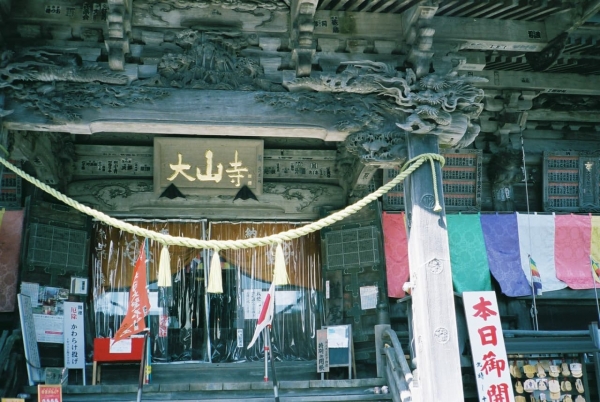Mount Oyama: Enjoy a 1-day hike on Kanagawa’s serene and sacred mountain

Easily accessible from Tokyo, Mount Oyama (大山 Ōyama) is located in the cities of Atsugi (厚木市 Atsugi-shi) and Isehara City (伊勢原市 Isehara-shi) of Kanagawa Prefecture (神奈川県 Kanagawa-ken). Included as part of the Tanzawa-Oyama Quasi-National Park (丹沢大山国定公園 Tanzawa-Ōyama Kokutei Kōen) and one of the Tanzawa Mountains (丹沢山地 Tanzawa-sanchi), Mount Oyama has been long heralded as a sacred destination due to its historical and religious significance. During the Tokugawa era, the 1,252m-high mountain was renowned for attracting many in Edo (江戸 olden day Tokyo) who sought pilgrimage and spiritual transformation.
Today, Mount Oyama’s storied past remains to be experienced within its scenic trails, rich nature, and religious artefacts by those wishing to find their own connection to the serene mountain.
Getting there

Isehara Station. (Image credit: Yuki K.)
To arrive at Mount Oyama, begin by travelling to Isehara Station (伊勢原駅) from Shinjuku Station (新宿駅) via the Odakyu Odawara Line (小田急小田原線 Odakyū-Odawara-sen) (¥600, 1 hour). Upon reaching Isehara Station, make your way out the North Exit and head to the #4 bus stand (4番線). Take the bus (¥300 yen one-way) to arrive at the base of Mount Oyama where you will find a conveniently located information centre.

(Left): Information center, (Right): A signboard of things to take note of before moving onwards. (Image credit: Yuki K.)
It is advisable for those wishing to scale Mount Oyama in its entirety to begin earlier in the day (~10am) as the trek will take several hours depending on climbing pace and the number of stops made. A short walk up from base will take you to the Oyama Cable Station (大山ケーブル駅 Ōyama kēburu-eki) as you pass by nifty shops selling intricate souvenirs alongside specialty restaurants serving popular local dishes all situated within a quaint setting.
Oyama Afuri Shrine: Hike or Cable Car?

Oyama Afuri Shrine. (Image credit: Yuki K.)

(Left) Drink and food vendors and (right) the famous Oyama Tofu. (Image credit: Yuki K.)
Once reaching the cable car station, you may opt to continue your ascent by cable car or on foot depending on your stamina and the time of day. Taking the cable car will bring you directly to a series of food vendors and shops which are a stone’s throw away from Oyama Afuri Shrine (阿夫利神社 Afuri-jinja), arguably the main attraction of the mountain and its midpoint. Here, one may enjoy a nice refreshing drink while savouring the delectable fresh taste of the famed Oyama Tofu made from pure spring water sourced right from the mountain itself!
Aburi-san Oyama-Dera

Oyama-dera. (Image credit: Yuki K.)
Forgoing the cable car and choosing to carry on by foot to Oyama Afuri Shrine will lead you onto two paths to which you must select one—the men’s trail (男坂 Otokozaka) or the women’s trail (女坂 On'nazaka)—with the former being steeper and the latter more milder. Both trails showcase interesting features and pass by the Aburi-san Oyama-dera (雨降山大山寺), a temple which can be traced back to the mid-8th century and is sure to be a memorable stop in any itinerary.

(Left): Metal statuettes of Fudo Myo-o which adorn the staircase. (Right): The overhung view from the top of the staircase. (Image credit: Yuki K.)
To reach Oyama-dera’s entrance, you will need to traverse up a steep staircase ladened with metal statuettes of the temple’s main deity of worship Fudo Myo-o (不動明王, also referred to as Acala). During autumn, the staircase is overhung by maple leaves teeming with vibrant shades of red and orange.
Oyama-dera’s unique goshuincho. (Image credit: Yuki K.)
Before leaving, for avid collectors of goshuin (御朱印 seal stamp), do not forget to add a new and distinctive stamp to your collection from here (and Oyama Afuri Shrine)! For those that may have forgotten to bring their goshuincho (御朱印帳 stamp book), do not possess one, or simply wish to add another to their collection, Oyama-dera sells an exquisitely designed stamp book that is sure to leave a lasting impression wherever you may choose to bring it next!

(Left): Statuettes of Eleven-headed Kannon. (Right) A larger statue of Eleven-headed Kannon that overlooks the area. (Image credit: Yuki K.)
The area around Oyama-dera also has several religious relics that should not be overlooked by those with time and energy to spare. If you decide not to trek up to Oyama-dera, however, fret not as it is accessible by cable car—Oyama-dera Station (大山寺駅 Ōyamadera-eki) serves as the intermediary station between Oyama Cable Station and Oyama Afuri Shrine Station.
Climbing to the summit

The rocky path to the top—do not be surprised to see many veteran elderly hikers zipping and zooming past you! (Image credit: Yuki K.)
After enjoying the sights and offerings of Oyama-dera and Oyama Afuri Shrine, those dedicated to journeying up to the summit of Mount Oyama may continue onwards by following the pathway to the left of Oyama Afuri Shrine. The remainder of the climb can take up to two hours and is sure to test the stamina of novice hikers looking to challenge themselves—ensure that you have appropriate footwear. While the trail to the top is clearly defined, some points may be considerably steeper than others. Be prepared to face rocky ground and set a climbing pace that is comfortable for yourself.

(Left): The entrance to the upper shrine. (Right) Artefacts within the upper shrine. (Image credit: Yuki K.)
At the summit of Mount Oyama, you will be met with the small upper shrine of the mountain, an observatory deck with benches and tables for snacking, and a splendid view of the Kanto Plain (関東平野 Kantō heiya). Additionally, there is a food vendor that sells light refreshments but, regrettably, was not open during my trek.

The deer of Mount Oyama. (Image credit: Yuki K.)
If you are fortunate enough to have made your climb on a clear and cloudless day, Mount Fuji can also be seen in the horizon. Despite being unable to catch a glimpse of Japan’s tallest mountain, I was lucky enough to spot some wildlife home to Mount Oyama! Once you have taken in all the allures of the peak, head back down and be mindful of your step. After reaching Oyama Afuri Shrine, either make your way to the base of the mountain by foot, if it is not yet dusk, or the cable car. For those taking the cable car, make note that the final departure time is 4:30pm on weekdays and 5:00pm on weekends and holidays.

The view from the top. (Image credit: Yuki K.)
In all, Mount Oyama offers an enjoyable day for both avid fans of the outdoors and those simply wishing to take a break from the hustle and bustle of the busy city. With the presence of a cable car, it is a flexible destination which easily caters to those who do not prefer undertaking a full hike yet still offers all the same rewards, discoveries, and experiences. A worthwhile visit, Mount Oyama is bound to excite any who make the journey!
Mount Oyama (大山)
Address: Nanasawa, Atsugi, Kanagawa 243-0121
Nearest station: Isehara Station (伊勢原駅)
Access: 30 minutes by Kanachu Bus #4 from Isehara Station
Trail difficulty: Moderate to challenging for beginners
Best season: Autumn, Winter
Opening hours (Oyama Cable Car): 9am–5pm
Admission fee (Oyama Cable Car): Visit Oyama Cable Car’s website for info.
Tel: +81 3 5321 7887
Header image credit: Yuki K.

Writers’ profile: Yuki resides in Tokyo, Japan. On most days, you'll find him wandering around the shopping arcades and alleys of Harajuku, Koenji, and Shinjuku.





